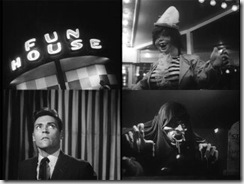I recall visiting a carnival when I was a kid, maybe 11 or 12. Outside of the fun house was a carney who was barking into a microphone.
“Take a visit you’ll never forget. Walk through the Chamber of Horrors and see unspeakable things. Be frightened in ways you cannot imagine!’”
I loved scary things…I had recently walked down the street with a friend and snuck in to see the movie ‘Alien’. I was 12, it scared the pants off me. I loved it. The carney didn’t know it but that was the benchmark I was using for comparison.
I walked up to him and asked, “What’s it cost?”
“Five tickets, kid.” He responded. I hesitated. He looked down at me and said, “Trust me kid, it’s worth it. You won’t sleep for the rest of the weekend.”
‘”It’s horrible?” I asked.
“Kid, like I said, you’ll be so scared you won’t be able to sleep tonight. How ‘bout those tickets? Head right in.”
I peeled off five tickets and handed it to the guy. So did my friend and we walked in, excited to be scared out of our wits in a matter of seconds. What would we see? Alien was good, but that was on a screen. This was real.
I remember that it smelled. Half the lights didn’t work and the ghouls and monsters were lame. The best part was moving catwalk on the second level and the giant tube which slowly spun you had to walk through on your way out. As we walked out, we both were disappointed.
“C’mon. Let’s go back to the Tilt-a-Whirl”, I said. “Whatta rip off”, my friend muttered.
Years later I reflect on this experience regularly as I encounter overtaxed marketing departments and their agencies working hard to generate messaging and deploying new tools and tactics in both traditional and social media spaces to try and get the consumer’s attention.
The issue is that these folks are getting the attention of their customers. Then in large part, that’s it. The experience from employee interaction to product interaction and billing are somebody else’s worry.
The problem is based in this flawed logic. Because marketing and their agencies do not directly tie their messaging to the ability of the business (note I do not say the brand) to deliver against this promise, the experience more often differs from the promise.
So should the Carney have changed his pitch? Would he have been better of ‘selling’ a mildly amusing and somewhat stinky two minute diversion? Probably not, he wouldn’t have gotten many takers. Moreover, he probably didn’t care if I ever went through again. His job was to collect as many tickets as possible.
The carney’s tickets are the equivalent to a customer’s transaction. Is the focus on the transaction or the experience after the transaction?
This morning I was in a Lexus dealership getting my vehicle serviced. I had my 3 year old daughter with me. I already own the truck and most of the maintenance I was getting was covered under warranty.
What is more important? The promise? Or the execution?
Here’s the execution I experienced this morning:
- A staffer takes my 3-year old daughter to the restroom, as the men’s is occupied. Helps her and washes her hands.
- I had my laptop but forgot my power brick. The dealership keeps one on hand for current models of Apple, HP, Sony and Dell.
- A service representative came out and informed me in 30 minute time blocks (I was there 2 hours) what my eta looked like. At one point, he made the rounds informing about 10 people.
- A text message from the dealership as I left, thanking me for my business and visit, as well as, the service manager’s number so I could give them a grade, A-F. It also indicated that since it was raining and although they washed my car to please return anytime for a replacement wash.
My wife’s car is a Saab (ok it’s really a GM Trailblazer with a some Saabish-style sheet metal and a console ignition). Recently, I took her car in for servicing. To say the experience was different that the one I describe above is an understatement At the GM dealership, the bare minimum was done in terms of supporting the brand promise. In my wife’s car’s case, everything was covered under warranty. I paid nothing. In my case, I had to unexpectedly write a check. But the brand promise and the businesses operational delivery were a world apart.
In the case of the Lexus, the expectation (the brand’s promise) matches so precisely meshes with Lexus & Toyota’s ability to execute that I didn’t care about having to write a check (as they explained what and why at the outset in as much detail as I wanted), even used examples/props!
So, think about putting your brand promise on a set of scales.
Does your brand promise, your advertising, your marketing, your social media programs pay off your operational activity and abilities? Are they in balance? Or not?
So, what’s in a promise?
Everything.



